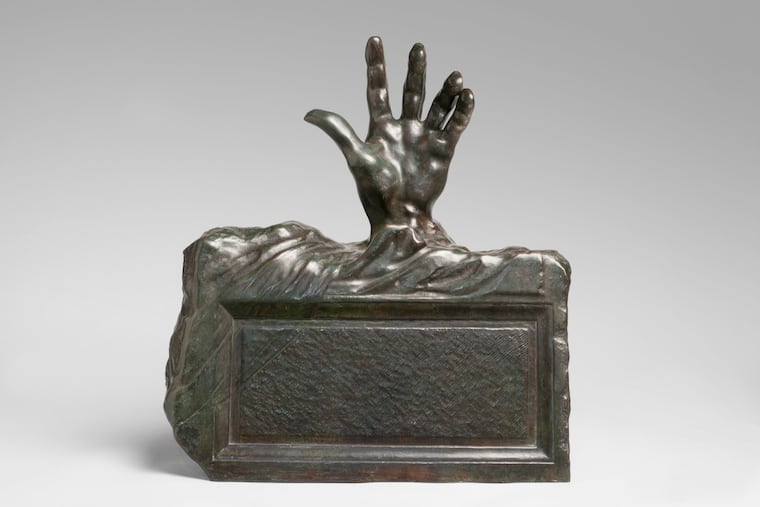Talk to the hand?
There’s truly no shortage of things to (digit-ally) muse about this fall inside the pay-what-you-wish Rodin Museum along the Benjamin Franklin Parkway at 22nd Street.
The fall exhibit is “Rodin’s Hands,” featuring casts and models of disembodied body parts by iconic sculptor Auguste Rodin, liberated from their bodies and doing way more than being merely tucked beneath the chin of The Thinker.
French critic Gustave Kahn wrote, “Rodin is the sculptor of hands — furious, clenched, rearing damned hands.” Rodin first exhibited the hands as independent works of art in 1900, when some critics viewed them as “sadistic and perverted for their severed or disembodied state,” according to exhibition materials.
And there is a bit of that quality, especially the hand reaching up from the boxlike tomb: Is it reminiscent of Thing from the Addams Family if you want to keep it light, or jump-scare creepy a la Carrie, if terror is your thing.
These hands are punching above their weight, emotionally and artistically.
In addition to reaching up from the tomb, Rodin’s hands are:
Clasped together around some sort of “secret.”
Touching fingers elegantly like the architectural ribs of a cathedral.
Alternately portraying the hands of the devil (left hand) and the hands of God (right hand).
Wrinkly and aging, a poignant self-portrait by the artist that includes a cast of a torso, also by Rodin.
After examining the hands around the sunny exhibition space, you’ll never look at a Rodin sculpture the same way.
The caressing hands, most likely those of Rodin and his companion Rose Beuret, are surprisingly tender, located just a few feet away from the angry clenched hand.
And in Rodin’s vision of creation, the hand of God “appears not from heaven but from the earth, and it cradles a rock from which a man and woman emerge,” according to the exhibition materials.
The portrayal of this hand of God, with its outstretched index finger, also appears on two different men in Rodin’s Burghers of Calais, a sculpture which is on view in the museum garden, in case you want a little hand scavenger hunt.
“Rodin’s Hands,” with 15 bronzes and plasters, many of them rare or unique to the Philadelphia collection, is on display through Jan. 4 at the Rodin Museum, 2151 Benjamin Franklin Parkway. Admission is pay what you wish.
Pictures of Belonging: Miki Hayakawa, Hisako Hibi, and Miné Okubo
The work of three women artists of Japanese descent working in the pre- and post-World War II years in California form the basis for the exhibition that opens at the Pennsylvania Academy of Fine Arts on Oct. 9.
Seen together for the first time, the work of Miki Hayakawa, Hisako Hibi, and Miné Okubo “reveals a broader picture of the American experience,” through their art and life stories, which took Hibi, Okubo, and Hayakawa’s parents to incarceration camps in Utah during World War II.
Composed of 70 paintings and drawings, and four sketchbooks, spanning eight generations, the exhibition’s stop at PAFA is its third of four before its final stop at the Japanese American National Museum in Los Angeles. Its previous stops included Utah and California, where all three artists exhibited in the prewar period.
Some of the paintings in the exhibition, including Wind and Dust (1943) by Okubo, and Hibi’s Eastern Sky, 7:50 A.M. (1945) and Western Sky, Topaz, Utah (1945) were painted inside the incarceration camps, where 120,000 people of Japanese descent were taken during World War II, after an executive order by President Franklin D. Roosevelt.
The paintings from that period stand in sharp contrast to the artists’ prewar work which saw Hayakawa painting Cezanne-esque cubist portraits of a man presumed to be her boyfriend, lounging on the floor; Okubo creating a series of idiosyncratic portraits: of a mother and boy, a grocer weighing produce, a self-portrait (Okubo), and Hibi painting cubist pastoral scenes.
Postwar, the images become more abstract, more influenced by graphic arts.
Lea Stephenson, PAFA’s coordinating curator for the exhibition, said “Pictures of Belonging” is drawing attention to three female Japanese American artists “that have not had the attention they deserve.”
“It’s an exhibition that makes us rethink what is American art, who is considered an American artist, especially in these historical moments,” said Stephenson, as her team prepares for: “A Nation of Artists: American Art at 250,” a major exhibition for the spring of 2026.
The period of Japanese internment in American camps is a period “the U.S. doesn’t like to acknowledge,” she said.
Hibi and Okubo continued to produce art while imprisoned at the Topaz Relocation Center in Utah between 1942 and 1944.
The show is chronological and shows the progression of the artists from their prewar styles that focused on communities and relationships.
The middle section reflects on the work created in the incarceration camps. And the third, postwar period, on art created after the women had moved to New York City to work in more graphic mediums. They become more geometric and graphic oriented, and reflect the bright colors of the postwar movements.
Okubo is also the author of Citizen 13660, her classic graphic memoir about her time in relocation camps.
Their work, Stephenson said, “is reflecting on what’s going on in American Art, abstract expressionism, gestural brushstrokes, the California style.”
“Pictures of Belonging” will be on view at PAFA Oct. 9-Jan. 4.

